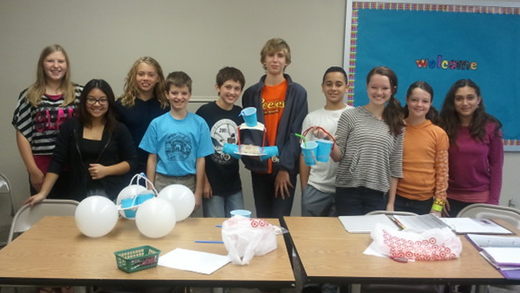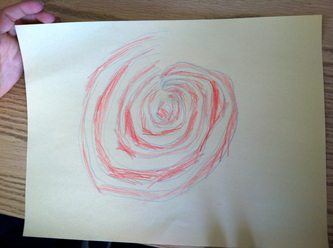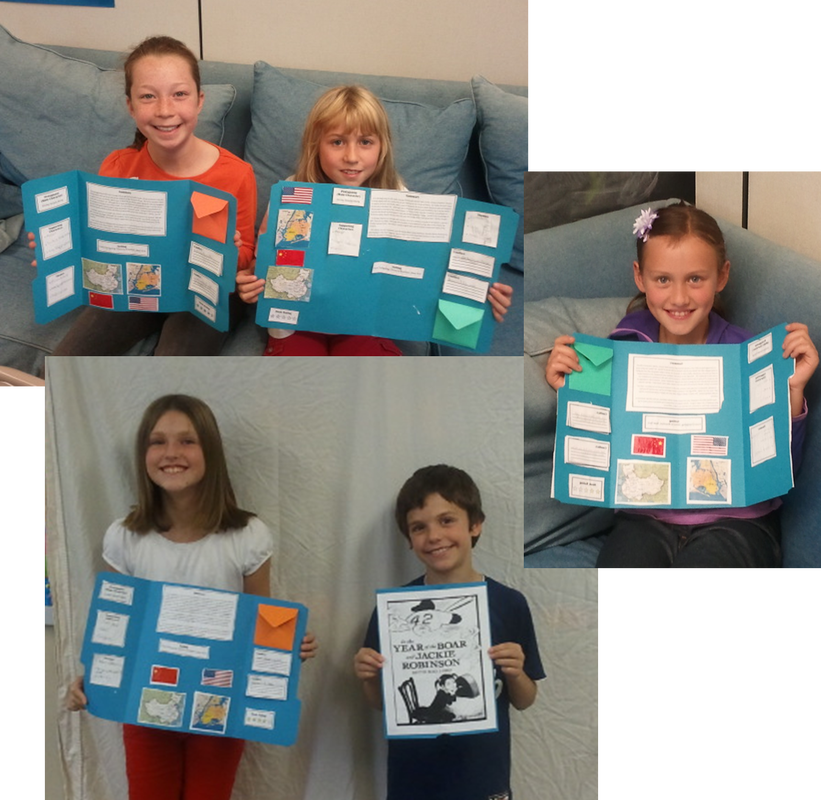 Class is cancelled for Monday, October 29, 2012, due to the impending arrival of Hurricane Sandy. We hope our students and their families stay safe, warm, and well-lit! We will communicate as much as possible regarding any work that students might be able to do on their own this week. Journalism families, in particular, I may have an idea on how to move forward without disrupting our publication schedule -- stay tuned later for details. Best wishes to all for a safe week!  We began our journey into the world of Treegap and Winnie Foster and the Tuck family this week with a discussion of the first five chapters of "Tuck Everlasting". The highly descriptive style of writing used by the author is a marked contrast from our previous book selection and most students are finding it harder to read and relate to the story for this reason. We discussed how the author uses abundant figurative language to paint a picture of the settings in the readers mind and weave a rich, suspenseful tale of fantasy. (Students should specifically look for examples of personification as part of their homework this week.) We re-read the Prologue together which introduces a major theme of the book - the circle of life, with a fixed center. The author explains that the year is like a Ferris wheel with a fixed hub, ever turning until it reaches the apex in August (the opening of the story) - a strange month of heat, stillness, and a propensity to make wrong decisions. I invited students to think of the wood and the spring in the story as a "fixed hub". How might life change if this hub was discovered and disturbed? We began looking at the characters introduced in the opening chapters and discussed what we know about them and how we feel about them so far. Everyone enjoyed sharing their stories of times they "almost" ran away from home (as Winnie is contemplating doing in the novel). The man in the yellow suit has really captured everyone's attention. What is he up to? Who is he looking for? Is he immortal, like the Tucks? Toward the end of class, we broke out the watercolors and colored pencils so that students could sketch and/or paint the huge ash tree and the spring, which are central to the theme of the book and Winnie's journey. Understanding that Natalie Babbitt was an illustrator long before she was an author helped the students better appreciate the powerful imagery of her writing style. Students should read at least through Chapter 10 for next week. My guess is that once they get drawn deeper into this story, they will not be able to put it down! (The book makes a wonderful read aloud as well.) Next week we will debate the value of immortality. Would it be a good to be able to live forever?  The last two weeks we have been focusing on preparing our articles and sections for publication and discussing what makes an editorial or opinion column effective and meaningful. A detailed email was sent last night listing each student's remaining editing responsibilities before final articles are due for submission, as well as any additional homework. After receiving their edited articles on Monday, October 29th, all written pieces, photography and art, and advertisements, must be emailed to me no later than November 2nd (preferably before, if completed). On Monday, we held a staff meeting workshop, which gave editors a chance to look over some of the articles and make suggestions to the reporters and authors. Our Comics writer staged two of her original comics frame by frame and we photographed them with the hopes of presenting a "real-ilfe" comic strip with Mosaic students as the stars! Several students who had written editorials shared their work, and other students volunteered to write op-ed pieces or letters-to-the-editor (either disagreeing or agreeing with the editorials) to be published in a future issue of The Mosaic Monthly. We then split into groups of two and challenged each group to write a suitable "hook" for an opinion piece on using the internet for educational purposes. We discussed some pros and cons of the issue and tried to use one of four techniques for writing a hook (description, startling statistic, question, or anecdote). Some students struggled with this a bit, but several nailed it on the first try. We are truly tackling some different writing styles in this class, and I know it has been a challenge to continually shift gears from week to week. We still have much to cover and will be publishing two more issues of our paper, so that all students will get a chance to write, edit, and create. If your student is having trouble editing their assigned work, it is acceptable to assist them at this stage. We will be spending an entire class on editing in the near future, in addition to many other topics that relate to writing and journalism. Next week we will decide on layout and placement of articles and sections, and start talking about our next issue. We may even learn about advertising and create some fun ads of our own. Spolier alert: There may be a J-Jargon challenge next week, but you didn't hear it from me!
 Students worked in small groups in class this week to finalize their prototypes of USEFUL inventions. Each group then developed and presented a marketing pitch to convince classmates of the usefulness and value of their item. All three groups, working separately, ended up building clever devices for holding... snacks! The Snack Glider is a combination snack/drink holder that doubles as a toy car - you can play for hours without the interruption of running to the kitchen for sustenance. The Float-A-Snacks is a nifty (waterproof) snack holder that floats along with you in the pool, so you can snack as you lounge, swim and sunbathe. The Snack Carrier 5000 is a three compartment snack caddy, with a convenient carrying handle that could come in handy at home, in the car, or even at the movie theater. Could it be that snacks are a mainstay of the 11-13 year old crowd? Probably! But a strong contributing factor to this 'snack theme' was certainly the fact that one of the everyday items provided as building supplies were plastic cups. We discussed once again the importance of divergent thinking, and how thinking "outside the box" could have led them to utilize the cups in more creative, non-standard ways. Other elements of their designs reflected greater creative use of the supplies - the use of two cups together with the paper plate as the body of the car, the use of popsicle sticks and tape to create a waterproof lid for the snack cup, the use of straws and pipe cleaners for structural elements and handles, the balloons as a sturdy, balanced floatation base.
All three groups did a fantastic job with their presentations, which were very creative and entertaining, especially for the short time they were given to develop and practice them. Each group was then ranked by their classmates in three categories: usefulness, creativity, and overall presentation. Congratulations to all groups for their outstanding creative collaboration! No take-home problems this week - get outside and enjoy these beautiful autumn days!
 Yesterday we really kicked up our creative thinking skills a notch with a friendly problem-solving competition! We divided into three teams by drawing numbers out of a paper bag. Students were asked to come up with names for their teams. Our teams were quite creative with names such as; Zen Yobi, Red Ice Pops, and the 27'ers! Although they might have been unaware, our goals for the day were elaboration, idea defense and team work! Each team was given 1-2 problems to solve in a time frame of anywhere from two to ten minutes for each problem or problem set. Children could work individually, but after arriving at an answer, must consult with their teammates before submitting the team's final answer. It was necessary to work quietly as any blurting of answers could cost your team a point. The students worked beautifully at this, and nary an answer was revealed. After the three teams had submitted an answer privately to the moderator, each team in rotation had a chance to present their solution to the group. If correct, the team scored an additional point above and beyond the question's stated point value, if wrong, the team lost a point! We learned an incredibly important lesson. Quick judgement of a problem often led to incorrect answers and lost points. More thoughtful consideration of a problem led to more correct answers and more points! Understanding that more can lie beneath the surface than appears at first glance is crucial to unraveling many of life's answers, including thinking circle questions. :0) Congratulations to the 27'ers for squeaking by with a one point win over Zen Yobi! We finished the day with a Sudoku Puzzle challenge. I provided each child with four puzzles, a few of them were able to complete the first one successfully, however, many students found them frustrating. If you would like to look over the puzzles this week with your student, I would encourage you to try to solve them together, as it may lead to a more relaxed view of the problem. This is an optional activity, but I'd like them to feel positive about the experience. Next week we'll be discussing, discovering and expressing visually the beauty of Infinity. We use curriculum from Art of Inquiry, LLC. What a delightful group of children join us each Monday for our early elementary class. They are inquisitive and talkative and interested in every activity we bring out. Our cultural geography studies are interwoven with math, reading, and writing games and opportunities.
We started out with the broad view of our world, and we are gradually getting closer to our study of New Jersey. Each week we enjoy a few chapters of Thorton Burgess's wonderful story, Happy Jack Squirrel. We are also watching a large maple tree in the front of the church for changes, and are each drawing pictures for a semester long book about the tree. Ask your children which tree it is, so that you can make observations together when you arrive. We have spent the first few weeks of class learning about the earth. Our first week of class we learned about the elements - earth, air, fire, and water - that make up our world, and talked about the animals that live in them. We loved making paper mache globes. Don't they look wonderful? The second week, we learned about the continents and read stories about children from around the world. We made a play house and dress up clothes out of silks, and imagined we lived somewhere far, far away. Last week we moved onto land forms, such as bays and capes, peninsulas and gulfs, isthmus and straights. We each made one out of clay, and next week we will paint them and bring them home. Next week we will finally arrive in New Jersey...at the shore. We are looking forward to learning about all of the creatures that we find in the ocean, both big and small, and remembering summer days gone by... Warmly, Kim & Sally Our students voted on two clubs for the Fall 2012 term. The winners were Drama and Strategy Games. Clubs are 45 minutes in length, student led and organized with minimal assistance from facilitators. Strategy Games Checkers Tournament
|
Categories
All
Archives
May 2016
|





















 RSS Feed
RSS Feed